




ORGANS OF PARIS © 2024 Vincent Hildebrandt HOME ALL ORGANS

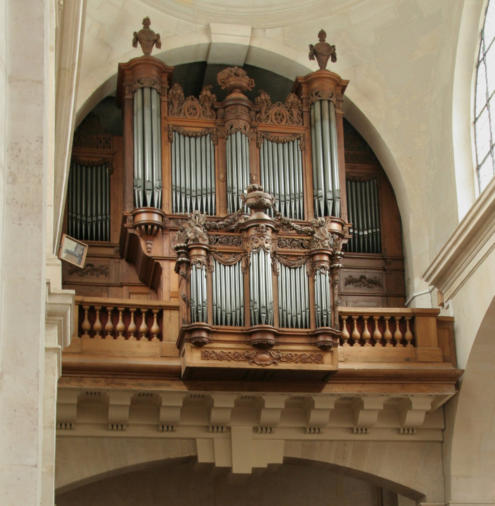

Saint-Jacques-du-Haut-Pas was built in the period
1630-1684. The portal is built in classical style, the
tower and buttresses are more gothic in appearance.
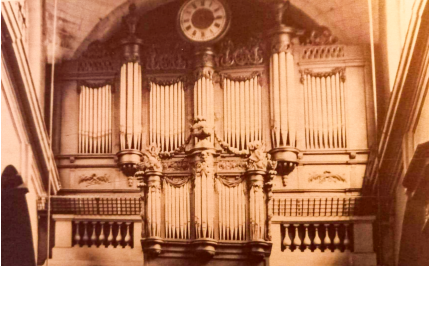
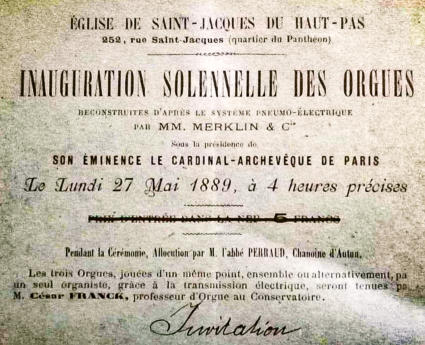
Organiste titulaire
Patrice Holiner
Concerts
-
Masses with organ
Saturday 6:15 PM, Sunday 10:00, 11:30 AM
Video
Patrice Holiner
All organs built before the revolution
Photo: Jeroen de Haan
1586 - Jean Langhedul (1)
160x - Matthijs Langhuedul (2)
1640 - Nicolas Pescheur (2)
1655 - Guy Jolly/Pierre Cauchois (2)
1673 - Alexandre et Charles Thierry (2)
1687 - François Ducastel/Bressart (2)
1767/84 - Nicolas Somer/François-Henri Clicquot (3)
1793 - Claude-François Clicquot (5)
1803 - Pierre Dallery (6)
1887 - Joseph Merklin (3a)
1908 - Joseph Gutschenritter (5)
1958 - Probst père et fils (6)
1971 - Alfred Kern (3)
1987 - Alfred Kern et fils (6)
IV/47 - traction mécanique
composition
D2
In 1792, the municipality of Paris offered the parish the organ
case of the nearby collegiate church of Saint-Benoît-le-
Bétournée (now disappeared). Claude-François Clicquot is in
charge of the transfer and reconstruction of a new instrument
(33/IV) in the historic buffet. Parts of the case date back to
1586, giving Saint-Jacques du Haut Pas the privilege of partially
owning the oldest organ case in Paris.
In 1969-1971 Alfred Kern built, inside the historic case, a large
instrument (47/IV) of classical design, entirely mechanical. The
back positive is restored and some pipes of the old organ are
preserved.
1586
The organ had been commissioned from the Flemish builder
Jean Langhedul, while the case was entrusted to the carpenter
Claude Delaistre. It was a small 4' organ with a single keyboard
of 45 keys and pull-out pedalboard. The instrument was
overhauled and enlarged in the early seventeenth century by
Mathieu Langhedul, son of the preceding, then Nicolas
Pescheur.
1640
The organ was equipped with a 2nd keyboard for a 3-foot back
Positive.
1655
Enlargement by Guy Jolly with redesign of the large case. The
work left unfinished by the latter was completed by Pierre
Cauchois: resumption of the GrandOrgue with addition of
Bourdon 16', installation of a 3rd keyboard of Echo, Pedal
extended to 29 notes.
1673
New campaign of work entrusted to the Thierry brothers
(Cymbal II rows on new Positive , wind tunnel replaced and
moved).
1687
Dismantling of the organ on the occasion of the replacement
of the tribune, by Ducastel and Bessart. The organ was
reduced to 4 keyboards for 31 stops, reaching the classical
ideal within the limits of its dimensions.
1767-1784
Major renovation, entrusted to Nicolas Somer, interrupted by
his death during the work. The work were taken up by
François-Henri Clicquot in two successive campaigns: repair of
the large wind chest, addition of a 5th Bombarde keyboard,
passage in 8' of the Positive, enlarged keyboards ... it is a
virtually new organ which, in 1784, came out of the hands of
Clicquot, and was soon made available by the
decommissioning of Saint-Benoît.
1793
After the organ of Saint-Benoît was awarded to the parish of
Saint-Jacques, an adequate tribune was built which made it
possible to install the case without having to modify it
significantly (slight enlargement). Claude-François Clicquot
took the opportunity to complete the Pedal.
1803
Overhaul by Dallery
1887-1889
A major reconstruction of the instrument was entrusted to
Merklin who emptied Ie Positif, and wanted to equip the organ
with the very recent electro-pneumatic system "Schmoële &
Mols", with a complex program of pairing the great organ with
the choir organ: the tribune organ was to have 29 stops, that
of the choir 15 stops, the two instruments being playable
simultaneously or alternately from a single console of 4
keyboards located in the choir. Some of the sound material
was reused, but according to the practices of the time, the new
pressure was increased.
1906-1908
The improvement of this random system was entrusted to
Gutschenritter, who combined the use of electricity and
tubular system (thus a new electropneumatic transmission
system, considered revolutionary at the time), lowered the
pressure, reharmonized the instrument by slightly reworking
the composition.
The large tribune organ and the small choir organ are paired: a
single console of four keyboards, placed in the choir behind
the altar, allows both instruments to be played alternately or
simultaneously. This was an attractive solution in theory, but
which, not taking into account the significant acoustic delay,
made it inconvenient and dangerous to use the tribune organ
from the choir. To remedy this, around 1920, the eminent
organist Achille Philip had a second console installed on the
tribune.
Although perfectly designed at the time, the electric
transmission gradually deteriorated and the instrument
became almost unplayable.
cont'd
1958
An overhaul carried out by Probst father and son
brought only a precarious improvement to the wear
of the electro-tubular traction. Soon after, the
connection with the choir organ disappeared with the
removal of the common console, but the instrument
became almost unplayable.
1969-1971
In 1964, it was decided to build a new instrument in
the tradition of "Alsatian syntheses", recently opened
in Paris at the organ of Saint-Séverin, an organ that is
able to meet as far as their compatibility the needs of
German music and the needs of the French classical
organ, referring to a tradition inaugurated once by
André Silbermann.
1987
Alfred Kern et fils carried out an overhaul and, at the
request of the titulaire Nicolas Gorenstein, exchanged
the 4' Clairon of the Récit (by Merklin) for a new
Douçaine 16' in order to obtain at this keyboard a
"16'-8'-4' battery".
Old stops
Stops of the XVIIIe century:
•
GO: Cornet V rangs G-O
•
Pedal: Trompette and Clairon
Stops of Merklin :
•
Positif: wooden pipes of the Bourdon 8.
•
GO: Montre 8, bass in wood of the Bourdon 16 and
Bourdon 8, Double Nasard, Voix humaine.
•
Récit: Trompette.
•
Echo: Hautbois
•
Pedal: Flûtes 16, 8, 4.
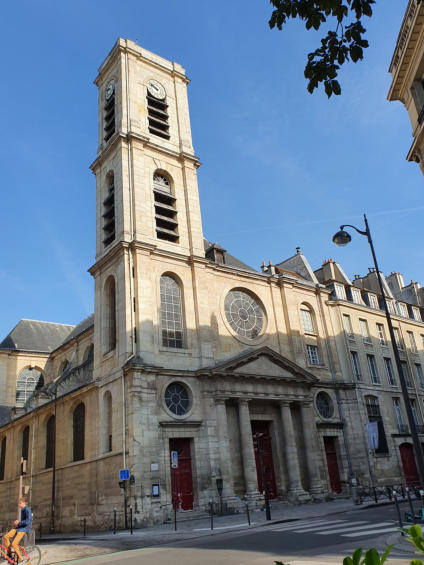
The organs of Paris
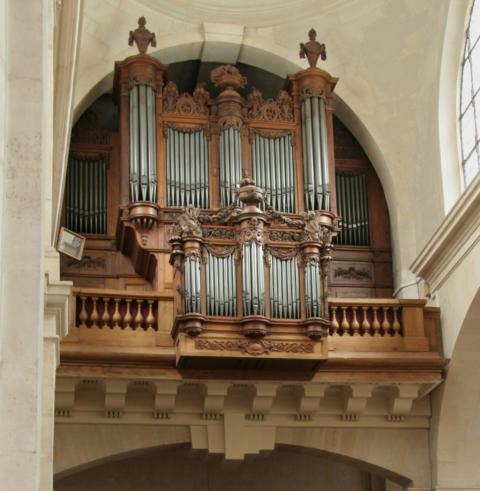
ORGANS OF PARIS © 2024 Vincent Hildebrandt ALL ORGANS
1586 - Jean Langhedul (1)
160x - Matthijs Langhuedul (2)
1640 - Nicolas Pescheur (2)
1655 - Guy Jolly/Pierre Cauchois (2)
1673 - Alexandre et Charles Thierry (2)
1687 - François Ducastel/Bressart (2)
1767/84 - Nicolas Somer/François-Henri Clicquot (3)
1793 - Claude-François Clicquot (5)
1803 - Pierre Dallery (6)
1887 - Joseph Merklin (3a)
1908 - Joseph Gutschenritter (5)
1958 - Probst père et fils (6)
1971 - Alfred Kern (3)
1987 - Alfred Kern et fils (6)
IV/47 - traction mécanique
composition
Organiste titulaire
Patrice Holiner
Concerts
-
Masses with organ
Saturday 6:15 PM, Sunday 10:00, 11:30 AM
Video
Patrice Holiner
All organs built before the revolution
Photo: Jeroen de Haan
D2
In 1792, the municipality of Paris offered the parish the organ
case of the nearby collegiate church of Saint-Benoît-le-
Bétournée (now disappeared). Claude-François Clicquot is in
charge of the transfer and reconstruction of a new instrument
(33/IV) in the historic buffet. Parts of the case date back to
1586, giving Saint-Jacques du Haut Pas the privilege of partially
owning the oldest organ case in Paris.
In 1969-1971 Alfred Kern built, inside the historic case, a large
instrument (47/IV) of classical design, entirely mechanical. The
back positive is restored and some pipes of the old organ are
preserved.
1586
The organ had been commissioned from the Flemish builder
Jean Langhedul, while the case was entrusted to the carpenter
Claude Delaistre. It was a small 4' organ with a single keyboard
of 45 keys and pull-out pedalboard. The instrument was
overhauled and enlarged in the early seventeenth century by
Mathieu Langhedul, son of the preceding, then Nicolas
Pescheur.
1640
The organ was equipped with a 2nd keyboard for a 3-foot back
Positive.
1655
Enlargement by Guy Jolly with redesign of the large case. The
work left unfinished by the latter was completed by Pierre
Cauchois: resumption of the GrandOrgue with addition of
Bourdon 16', installation of a 3rd keyboard of Echo, Pedal
extended to 29 notes.
1673
New campaign of work entrusted to the Thierry brothers
(Cymbal II rows on new Positive , wind tunnel replaced and
moved).
1687
Dismantling of the organ on the occasion of the replacement
of the tribune, by Ducastel and Bessart. The organ was
reduced to 4 keyboards for 31 stops, reaching the classical
ideal within the limits of its dimensions.
1767-1784
Major renovation, entrusted to Nicolas Somer, interrupted by
his death during the work. The work were taken up by
François-Henri Clicquot in two successive campaigns: repair of
the large wind chest, addition of a 5th Bombarde keyboard,
passage in 8' of the Positive, enlarged keyboards ... it is a
virtually new organ which, in 1784, came out of the hands of
Clicquot, and was soon made available by the
decommissioning of Saint-Benoît.
1793
After the organ of Saint-Benoît was awarded to the parish of
Saint-Jacques, an adequate tribune was built which made it
possible to install the case without having to modify it
significantly (slight enlargement). Claude-François Clicquot
took the opportunity to complete the Pedal.
1803
Overhaul by Dallery
1887-1889
A major reconstruction of the instrument was entrusted to
Merklin who emptied Ie Positif, and wanted to equip the organ
with the very recent electro-pneumatic system "Schmoële &
Mols", with a complex program of pairing the great organ with
the choir organ: the tribune organ was to have 29 stops, that
of the choir 15 stops, the two instruments being playable
simultaneously or alternately from a single console of 4
keyboards located in the choir. Some of the sound material
was reused, but according to the practices of the time, the new
pressure was increased.
1906-1908
The improvement of this random system was entrusted to
Gutschenritter, who combined the use of electricity and
tubular system (thus a new electropneumatic transmission
system, considered revolutionary at the time), lowered the
pressure, reharmonized the instrument by slightly reworking
the composition.
The large tribune organ and the small choir organ are paired: a
single console of four keyboards, placed in the choir behind
the altar, allows both instruments to be played alternately or
simultaneously. This was an attractive solution in theory, but
which, not taking into account the significant acoustic delay,
made it inconvenient and dangerous to use the tribune organ
from the choir. To remedy this, around 1920, the eminent
organist Achille Philip had a second console installed on the
tribune.
Although perfectly designed at the time, the electric
transmission gradually deteriorated and the instrument
became almost unplayable.
cont'd
1958
An overhaul carried out by Probst father and son
brought only a precarious improvement to the wear
of the electro-tubular traction. Soon after, the
connection with the choir organ disappeared with the
removal of the common console, but the instrument
became almost unplayable.
1969-1971
In 1964, it was decided to build a new instrument in
the tradition of "Alsatian syntheses", recently opened
in Paris at the organ of Saint-Séverin, an organ that is
able to meet as far as their compatibility the needs of
German music and the needs of the French classical
organ, referring to a tradition inaugurated once by
André Silbermann.
1987
Alfred Kern et fils carried out an overhaul and, at the
request of the titulaire Nicolas Gorenstein, exchanged
the 4' Clairon of the Récit (by Merklin) for a new
Douçaine 16' in order to obtain at this keyboard a
"16'-8'-4' battery".
Old stops
Stops of the XVIIIe century:
•
GO: Cornet V rangs G-O
•
Pedal: Trompette and Clairon
Stops of Merklin :
•
Positif: wooden pipes of the Bourdon 8.
•
GO: Montre 8, bass in wood of the Bourdon 16 and
Bourdon 8, Double Nasard, Voix humaine.
•
Récit: Trompette.
•
Echo: Hautbois
•
Pedal: Flûtes 16, 8, 4.






















